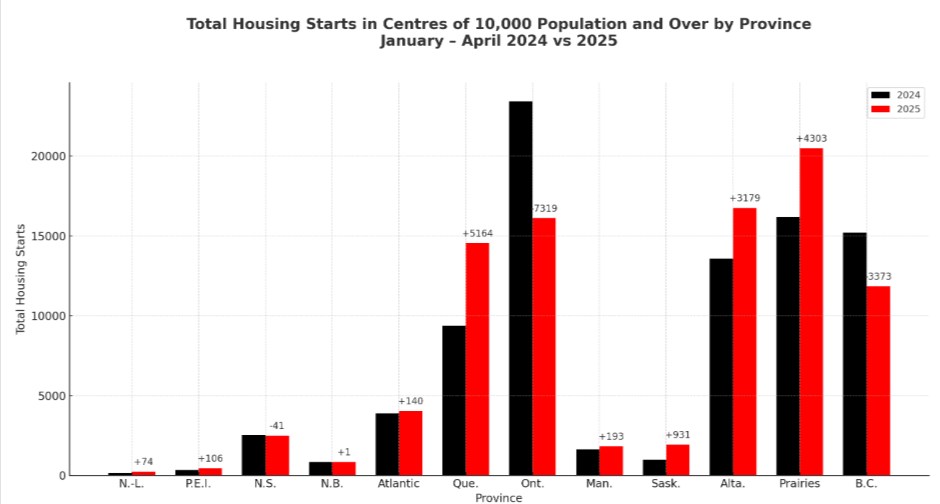
In April 2025, Canadian builders broke ground on new residential construction at an unprecedented pace for that month, according to figures released by the Canada Mortgage and Housing Corporation (CMHC) on May 15, 2025. The seasonally adjusted annual rate (SAAR) of housing starts jumped 30%, from 214,205 units in March to 278,606 units in April, while the six‑month moving average climbed 2.4% to 240,905 units. On an actual basis, urban centres with populations of 10,000 or more recorded 21,720 starts in April, a 17% increase over the 18,539 units in April 2024 and the highest April total on record.
Source: CMHC (Actual Numbers)
Québec’s Multi‑Unit Boom
Québec led all provinces in April’s surge, igniting a resurgence that has carried over since the start of the year. Between January 1 and April 30, 2025, Québec saw 14,550 housing starts, up 55% from the same period in 2024. Multi‑unit projects, such as condominiums and apartment buildings, accounted for the lion’s share of this growth: in April alone, multi‑unit starts jumped 71% year‑over‑year, from 2,310 units in April 2024 to 3,954 units this April.
Prairies Perform Strongly
Alberta and Saskatchewan also delivered outsized gains in early 2025. From January through April, combined starts in the Prairie provinces rose 27% to 20,492 units, compared with 16,189 in the first four months of 2024. Saskatchewan’s total nearly doubled for a 94% increase, to 1,924 starts, driven by a 100% rise in multi‑unit construction. Alberta registered 16,749 starts, a 23% year‑over‑year increase, buoyed equally by single‑detached and multi‑unit projects. In April alone, Prairie starts climbed 33% to 6,365 units, likely suggesting a readiness to meet growing demand in cities like Calgary and Edmonton.
Ontario and B.C. Lag
Despite national gains, Ontario and British Columbia struggled to keep pace. Ontario’s actual April starts fell 10% to 5,177 units from 5,774 in April 2024, while its January‑to‑April total of 16,115 was down 31% from 23,434 in the same span of 2024. In BC, builders initiated 4,328 units in April, a 3% decline from 4,467 in April 2024, bringing the province’s January‑to‑April total to 11,839 starts, with numbers 22% below the 15,212 recorded a year earlier. High land and construction costs, combined with cooling demand amid higher borrowing rates, have restrained activity in these markets.
Starts by Major Cities

Source: CMHC (Actual Numbers)
In April 2025, Montréal led Canada’s major markets with 1,959 housing starts, which was 64% more than the 1,194 units begun in April 2024, driven by a surge in multi‑unit construction. Calgary followed closely, with 3,102 starts in April, a 69% jump from the 1,831 recorded a year earlier, while Edmonton saw a more modest 12% gain, rising from 1,656 starts in April 2024 to 1,861 in April 2025. Vancouver’s builders initiated 3,085 units in April, up 6% over the 2,718 starts of April 2024, and Ottawa–Gatineau nearly tripled its output, soaring 254% from 447 to 1,584 units. By contrast, Toronto experienced a downturn in April, with 2,290 starts, 25% fewer than the 3,054 units started in April 2024.
Looking instead at the first four months of 2025 combined, Calgary’s cumulative January‑to‑April total reached 9,373 units, a 30% rise compared with 7,216 during the same period in 2024, while Montréal’s year‑to‑date figure climbed 82% to 7,286 starts, up from 4,009. Edmonton’s January to April total of 5,956 units marked a 16% increase over the 5,143 starts in early 2024, even as Vancouver’s volume fell 25% to 7,919 units (down from 10,540) and Toronto’s plunged 52% to 7,362 starts, down from 15,202. Ottawa–Gatineau posted strong year‑to‑date growth, nearly doubling its early‑year output to 4,193 units, 96% more than the 2,142 starts logged from January through April 2024.
Balancing Spring’s Strength with Year‑to‑Date Lulls
Although April’s figures offer cause for optimism, the year‑to‑date picture remains mixed. Canada-wide, the 67,022 starts recorded from January 1 through April 30 were 2% below the 68,107 units initiated in the same period of 2024.





